Why Buyer Personas?
Buyer personas today are more important than ever when it comes to developing your business. Why? Because not only are customers inundated with more products and services than ever before, they are increasingly searching for emotional connection with a brand and its products.
In other words, if you can empathize with your customers and know what makes them tick, you’re one step closer to providing a meaningful and valuable experience, leading to more sales and increased retention of customers over time.
What is a buyer persona?
Buyer personas are fictional. They’re created based on your target audience and existing customers if you’ve already reached that point. A marketers favourite imaginary friend, they give direction to product and content.
By separating customers into umbrella groups representing demographics, goals, background and more you can begin to really understand what certain customers are looking for in the service you’re providing.
Customer discovery
The more you understand about real customers you’re already working with, the more developed your buyer personas will be. This means you’ll want to get insights on either actual buyers or people you think could be potentially interested in your product.
There are different ways you can go about doing this. A great way is to build up a database of customer information created from customer discovery interviews. This gives you a direct path into your customers’ thinking and experience.
For more on Customer Discovery take a look at our latest Ebook here. Or, for info on how to carry out remote customer discovery interviews, click here.
Once you have these insights on your customers, you’re ready to follow the 3 steps to create the buyer personas your business needs.

Step 1: Think Details
Yes, your buyer persona is fictional, but that doesn’t stop you from going into details on their age, background, interests, likes, the list goes on.
If you don’t feel comfortable asking these details directly in an interview, you can ask customers to fill out a questionnaire on your website or via email.
To develop your personas we recommend taking a look at the following details:
- Demographics – This is one of the easier details to add. It’s made up of things like age, gender, location.
- Background – Information on the customer’s country of origin, education, socio economic situation
- Interests – This is more subjective but it could include things like interest in politics, technology, education. A great place to find out information like this is via social media profiles.
- Identifiers – This could include information about life stage, behaviours, communication preferences.
Step 2: The Bigger picture
Once you’ve thought about these smaller details, it’s time to zoom out on the big picture, thinking about the goals, motivations and challenges of each persona.
Starting with goals, ask yourself: “what are the kind of things this persona is aiming for?” “What do they want to achieve?”
Maybe it’s something very tangible like having a successful business or, it could be something more related to emotional well-being like reducing stress in their everyday life.
Onto motivations, you’ll need to decide what is motivating your customer, what gets them out of bed in the morning. If we think about the ‘creating a successful business’ example mentioned above, maybe they are motivated by a need for financial security, or maybe they want to make a real change in the world by starting their own venture.
Now those are clear, think about the challenges your customer faces. Taking the example mentioned above, if they’re looking for a ‘stress free’ lifestyle, perhaps they’re struggling to achieve a work life balance.
In addition to this, if you’ve noted down direct quotes from customer discovery interviews, it’s a good idea to match these to the ‘goals’ ‘motivations’ and ‘challenges’ of the personas you create.
Step 3: Negative personas
Now you’ve got all of the details on the kinds of buyer personas you do want, it’s a good idea to understand the kinds of customers you don’t want to target to avoid future issues such as low customer satisfaction or reduced impact if you’re an impact focused company.
For example, if you’re running a bootcamp on digital marketing perhaps you decide you only want to accept students with certain qualifications or over a certain age. This means the students that enter will be suited to the course, decreasing dropout rates and improving their experience.
The result of this? Students are more likely to share about your course on social media, leave reviews, become ambassadors etc and you’re not investing time and money into students that are less likely to get value from your service.
Conclusion
Buyer personas help you see your product from your customers’ perspective. Although you may think you’ve got the winning formula, you can’t be sure until you understand the true needs of your customer and then meet (or exceed) them.
Join Us.
If you didn’t know, we’re on a mission to democratize access to entrepreneurship education. We support early-stage entrepreneurs in developing the businesses our society needs through our 3 month, online program, The Leap.
If, like these founders, you want to develop your project with us and join the purpose-driven movement, click here.
Or, if you’re already a member of the Bridge community and you’d like us to share your story, send an email over to phoebe@bridgeforbillions.org.




